My landscape edging education began with what I now call the Great Mulch Migration of 2016. Three weeks after installing new garden beds in our Minneapolis Tudor’s backyard—complete with the black plastic edging the big box store employee assured me would “keep everything in place”—I stood staring at what looked like a crime scene. Heavy rain had transformed our carefully selected hardwood mulch into a floating armada that breached the flimsy plastic barriers and ran across our lawn like chocolate syrup on vanilla ice cream. The newly planted perennials sat exposed and dejected, while the once-crisp edge between lawn and garden bed had devolved into a muddy, indeterminate border zone.
As I shoveled soggy mulch back into place for the third time that month, I had an epiphany that’s guided my approach to landscape design ever since: edging isn’t decorative—it’s infrastructure. Those seemingly minor borders between different landscape zones perform critical functions beyond aesthetics, preventing material migration, establishing clear maintenance boundaries, and providing structural support that allows different elements to coexist without bleeding into each other. And like all infrastructure, quality and proper installation matter far more than most people realize until something fails.
This realization launched what Andrea calls my “edging obsession”—a deep dive into different approaches across various regions and conditions. What I discovered is that successful landscape edging isn’t universal. The perfect solution for an Arizona xeriscaped yard would fail miserably in Seattle’s constant moisture. The ideal border for Minnesota’s freeze-thaw cycles might prove completely unnecessary in Southern California’s stable soil conditions. And surprisingly, the most expensive options aren’t always the most effective for specific contexts.
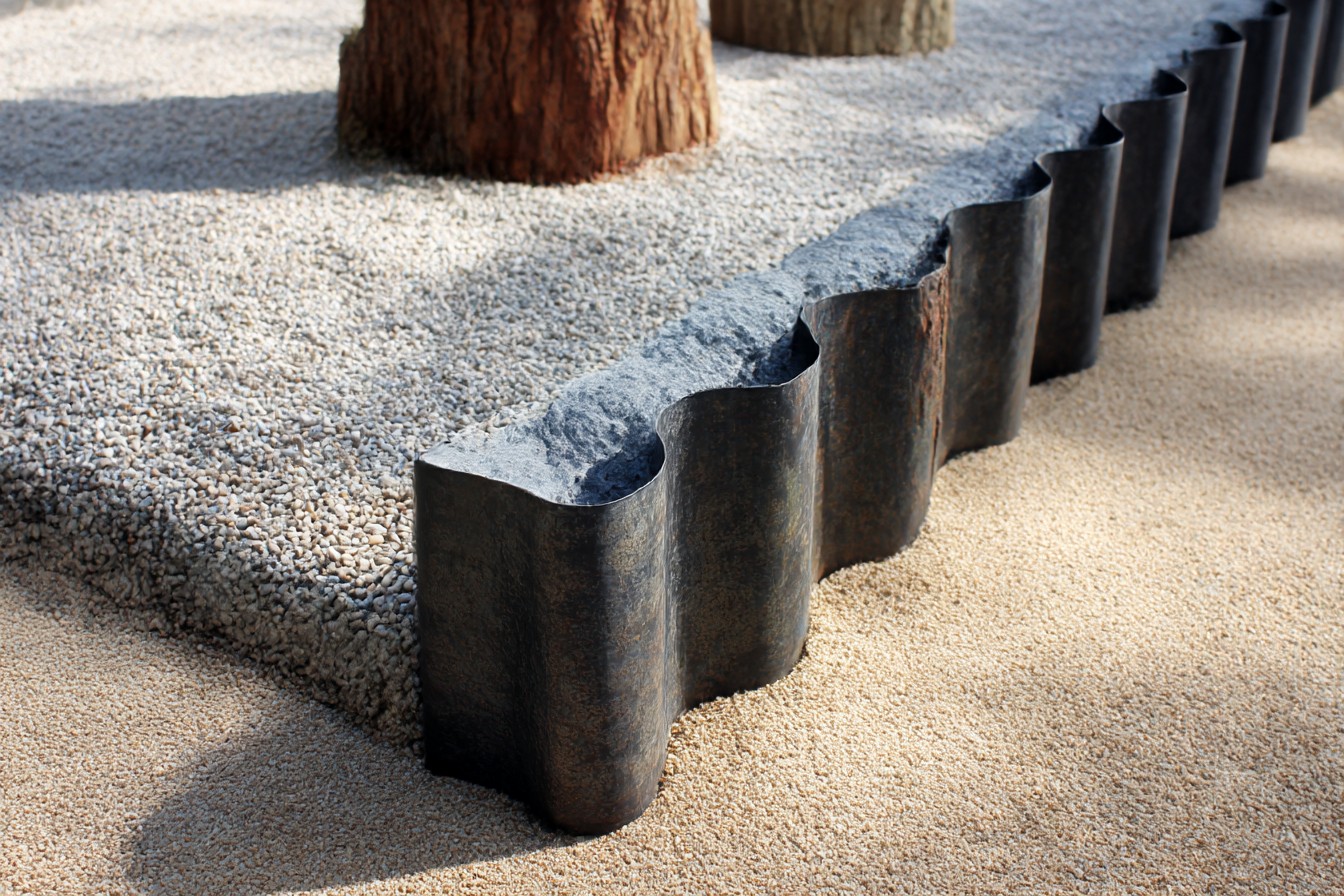
The fundamental problem with those ubiquitous black plastic strips is their failure to address the actual forces they’ll encounter. In our Minneapolis landscape, frost heave pushed them upward each spring, while summer lawn mowing gradually damaged exposed edges. By their second season, they’d become more hazard than help—partially visible in some areas, completely dislodged in others, and ineffective everywhere. The $88 I “saved” compared to more substantial options cost me countless hours of maintenance and replacement over just two seasons.
Stone edging provides one of the most durable alternatives, with specific considerations for different regions. For a client in Colorado dealing with erosion on a sloped property, we installed irregular sandstone pieces partially buried at different depths. This created a naturalistic border that effectively contained soil and mulch while harmonizing with the native landscape. The stone’s substantial weight prevented migration even during heavy rainfall, while its irregular appearance accommodated the property’s organic design approach.
For more formal settings, cut stone edging offers precision and permanence that manufactured options rarely match. A Boston client with a historic home requested garden borders appropriate to the property’s Federal-style architecture. We selected cut granite blocks installed with minimal visible mortar, creating a refined edge that contained European-style perennial beds while visually connecting to the home’s original granite foundation. While certainly not the least expensive option at roughly $32 per linear foot installed, the century-plus lifespan of properly installed stone edging makes it remarkably cost-effective over time.
Regional material availability dramatically impacts both aesthetics and budget for stone edging projects. In Minnesota, locally quarried limestone provides a readily available, contextually appropriate option that costs roughly half what imported stone would require. For our own garden beds, we selected 4-inch limestone pieces with naturally irregular tops and machine-cut sides, creating a border that effectively contains our perennial gardens while harmonizing with both our Tudor’s architecture and the neighborhood’s overall character. The installed cost—approximately $18 per linear foot—seemed significant initially but has required zero maintenance over five Minnesota winters.
Metal edging offers distinct advantages when properly selected and installed. For a contemporary landscape in Chicago, we specified ¼-inch corten steel edging that would develop a naturally protective rust patina over time. The material’s strength allowed for creating perfectly straight lines and precise curves that complemented the home’s modern architecture, while its narrow profile disappeared visually when viewed from most angles. At approximately $14 per linear foot installed, it represented a middle-ground investment that delivered both aesthetic refinement and exceptional durability.
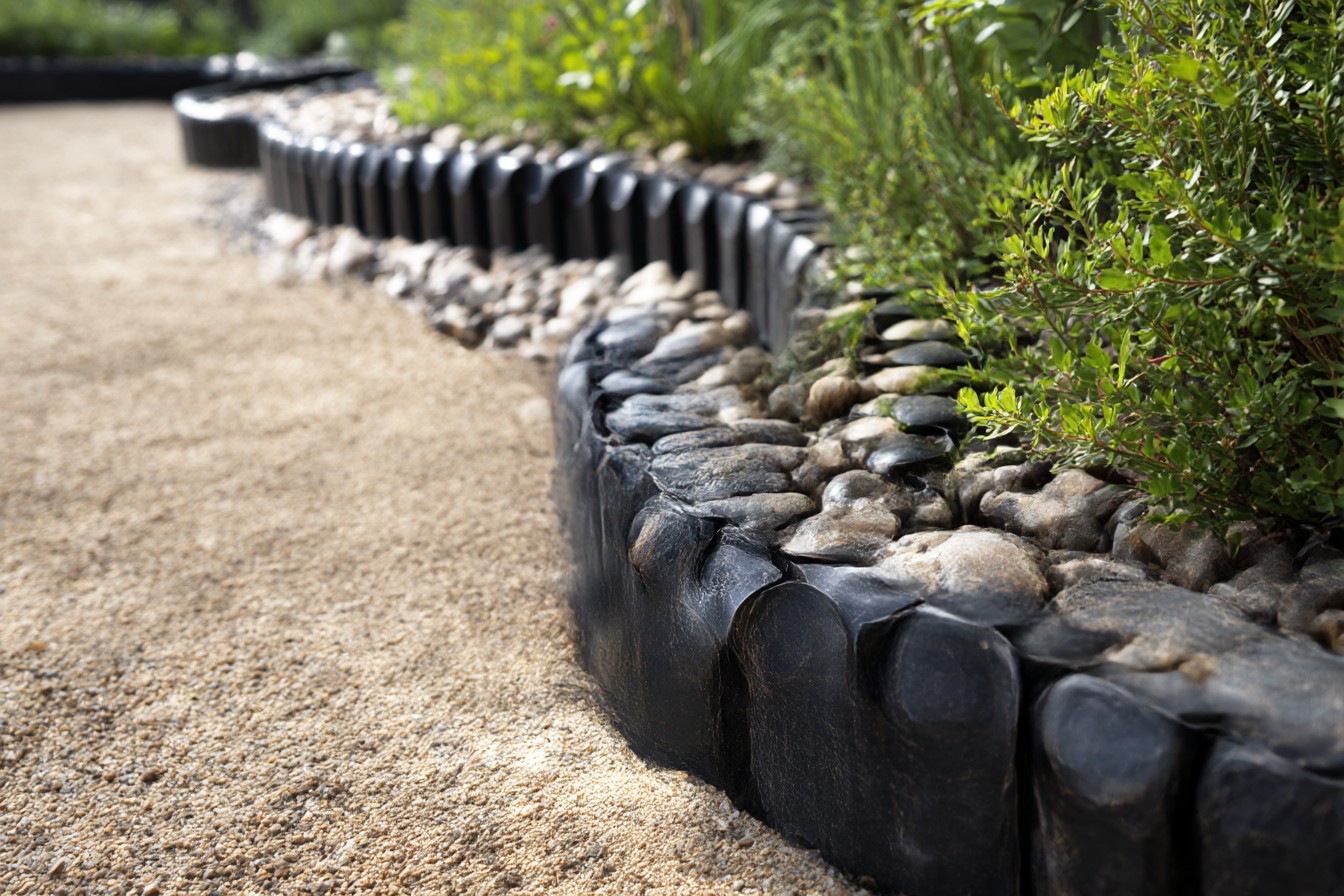
Aluminum edging provides a lighter-weight alternative with specific advantages in certain applications. For a Seattle client with extensive woodland gardens containing native plants, we selected powder-coated aluminum in a forest green finish. The material’s flexibility allowed it to navigate around existing tree roots without damaging them, while its corrosion resistance stood up to the region’s notorious rainfall. When properly anchored with stakes every 24 inches, this relatively lightweight option has proven remarkably effective at containing mulch and defining maintenance boundaries in challenging conditions.
The primary failure point for metal edging typically isn’t the material itself but inadequate installation depth. A Denver client called me about edging that had “completely failed” after a single season, only to discover the contractor had installed it with barely 2 inches of material below grade. Without sufficient anchoring depth, even the most robust metal edging eventually works loose through freeze-thaw cycles, root pressure, and regular landscape maintenance activities. For our Chicago project, we specified minimum 4-inch below-grade installation with additional stakes at all curves and transitions, significantly improving long-term performance.
Concrete edging offers exceptional durability with a surprising range of aesthetic options beyond the basic poured curb. For a Minneapolis client with a mid-century modern home, we selected formed concrete edging with a slightly radiused top edge that referenced the home’s architectural details. While more involved to install than pre-fabricated options, custom concrete allows for incorporating site-specific curves, elevation changes, and transitions that perfectly match the landscape design intent. At approximately $22 per linear foot, it represented a significant investment that has remained flawless through seven Minnesota winters.
For more budget-conscious projects, concrete paver edging provides many similar benefits at lower cost. A client in Michigan with extensive perennial gardens selected thick concrete pavers installed vertically along garden borders, creating defined edges that effectively contained mulch while providing a stable mowing strip for lawn maintenance. The materials cost significantly less than poured concrete (approximately $3-4 per linear foot versus $18-24), though installation labor remained comparable. The resulting border successfully manages the region’s substantial freeze-thaw cycles while accommodating extensive perennial root systems.
Mortared brick edging offers traditional appeal for appropriate architectural contexts. For a historic home in Charleston with formal gardens, we specified antique clay bricks installed in a sailor course (standing on end) with lime-based mortar matching the home’s original construction. This approach created authentic period detail while providing the structural integrity necessary to contain formal boxwood parterre gardens. For historic properties, this investment in appropriate materials—roughly $28 per linear foot installed—preserves architectural integrity while providing genuine durability that manufactured alternatives rarely match.
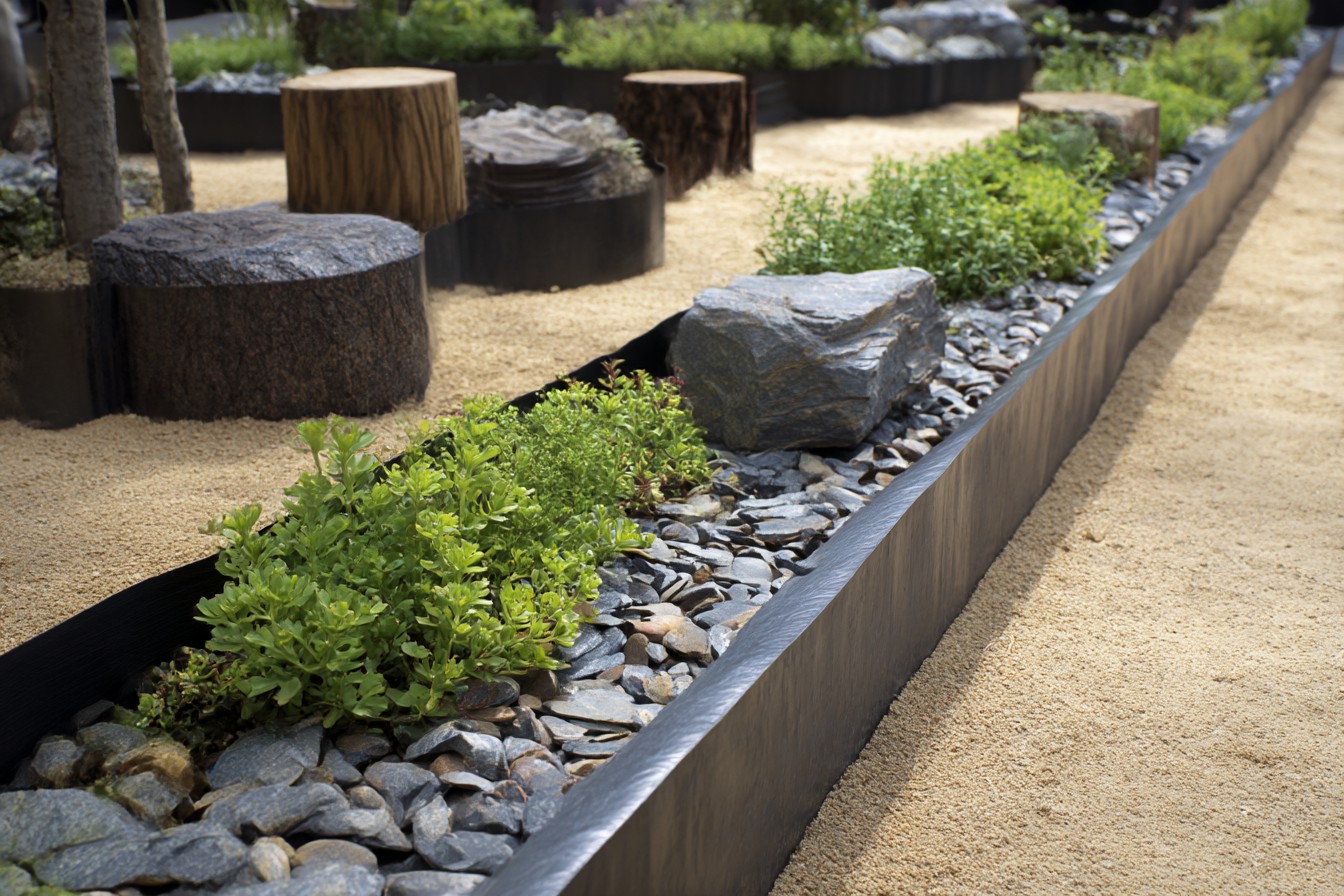
In regions with moderate climates and minimal freeze-thaw activity, dry-laid brick provides similar aesthetic appeal with simpler installation. A client in Northern California with a craftsman bungalow selected dry-laid antique brick positioned vertically to edge cottage-style perennial beds. The unmortared installation allows for easy adjustments as plants mature and expand, while the substantial weight of the brick prevents movement during normal conditions. This approach wouldn’t survive Minnesota winters but performs beautifully in milder climates where frost heave isn’t a primary concern.
For naturalistic landscapes, particularly in regions with native stone, boulder edging creates seamless transitions between different zones. A Colorado client with a mountain property selected carefully positioned local granite boulders to define the boundary between cultivated landscape areas and the surrounding natural environment. Rather than creating a harsh delineation, this approach establishes a graduated transition that feels appropriate to the setting while still providing necessary functional separation between different maintenance zones.
In regions with substantial timber resources, wood edging offers contextually appropriate solutions with important material considerations. For a Seattle project with woodland gardens, we selected 6×6 cedar timbers partially buried to create garden borders with natural rot resistance appropriate for the extremely wet conditions. Unlike pressure-treated lumber that can leach chemicals into soil, naturally decay-resistant woods like cedar, redwood, or black locust provide safe options for edging vegetable gardens and environmentally sensitive locations, though with shorter lifespans than stone or concrete alternatives.
For curved applications where timber might prove too rigid, manufactured composite options have improved dramatically in recent years. A client in Portland with winding garden paths selected flexible composite edging made from recycled materials that provided the necessary curves while offering significant durability advantages over traditional wood. With a 20+ year expected lifespan and minimal maintenance requirements, these materials offer legitimate ecological advantages in appropriate applications despite their synthetic origin.
Installation technique dramatically impacts performance regardless of material selection. One of the most common errors I encounter is insufficient base preparation—attempting to install substantial edging directly onto existing soil without proper compaction or base materials. For our limestone edging in Minneapolis, we established a 3-inch crushed stone base thoroughly compacted before setting stones. This extra step—adding perhaps 15% to installation costs—prevents settling and movement that would otherwise compromise even the most substantial materials over time.
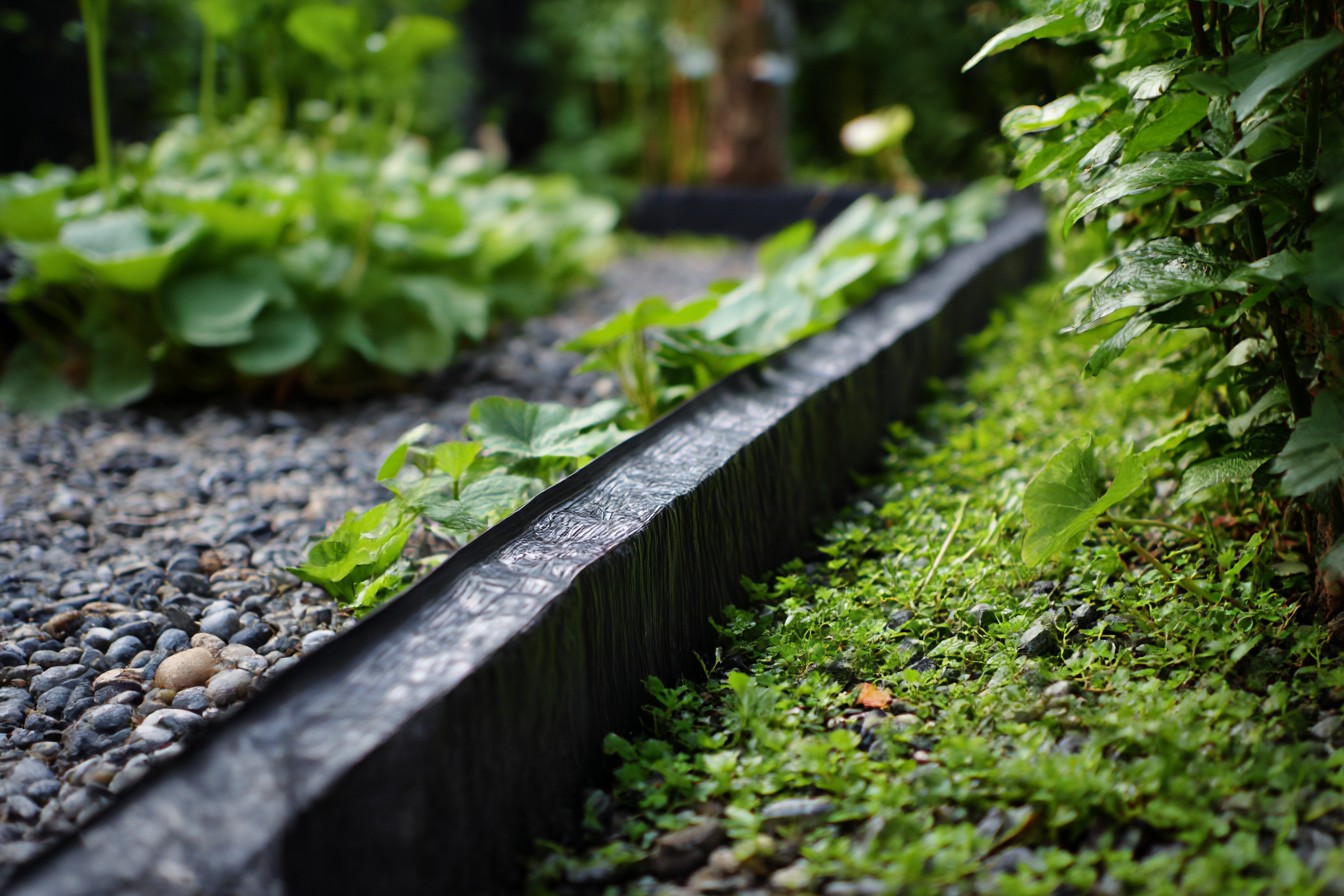
For regions with significant rainfall, proper drainage consideration becomes crucial for successful edging. A Seattle client experienced repeated mulch washout despite substantial concrete edging because the installation created a damming effect that channeled water along the border rather than allowing appropriate drainage. For their redesigned borders, we incorporated periodic drainage gaps with filtered gravel to maintain visual continuity while allowing water to move naturally through the landscape. This hydrological consideration transformed a frequently failing edge into a permanently functional boundary.
Edging height relative to different materials significantly impacts both aesthetics and functionality. A common mistake involves installing borders at the same height as adjacent lawns, which inevitably leads to grass growing over the edge and blurring the intended separation. For our Minneapolis garden beds, we positioned limestone edging approximately 1.5 inches above the lawn surface, creating both a visual boundary and a functional mowing strip that prevents grass encroachment while still allowing mower wheels to roll along the border for clean maintenance.
Conversely, edging installed too high above mulched areas creates unnecessary material dams that prevent natural water sheet flow and create awkward visual transitions. A Chicago client had installed concrete edging nearly 4 inches above their mulch level, creating what appeared to be floating garden beds rather than natural landscape transitions. By adjusting mulch levels to within 1.5 inches of the edging top, we transformed both the aesthetic appearance and functional performance of the existing borders without replacing materials.
Corner and transition details often reveal the difference between professional-quality installations and DIY approaches. For a Minneapolis project with metal edging, we specified welded corners rather than overlapped sections, eliminating common failure points where separate pieces meet. For our own limestone borders, we selected larger cornerstone pieces that anchored the entire installation while providing visual emphasis at directional changes. These seemingly minor details disproportionately impact both appearance and long-term performance.
Maintenance buffer design significantly impacts edging longevity regardless of material selection. A client in Chicago installed beautiful cut granite edging directly adjacent to their driveway without considering snow removal impacts. The first winter, their snowblower repeatedly struck and eventually damaged several sections. For northern properties, designing appropriate setbacks or protective elements for edging adjacent to cleared areas prevents unnecessary damage while maintaining landscape definition. Sometimes the most effective design decisions involve anticipating predictable maintenance activities rather than addressing only aesthetic concerns.
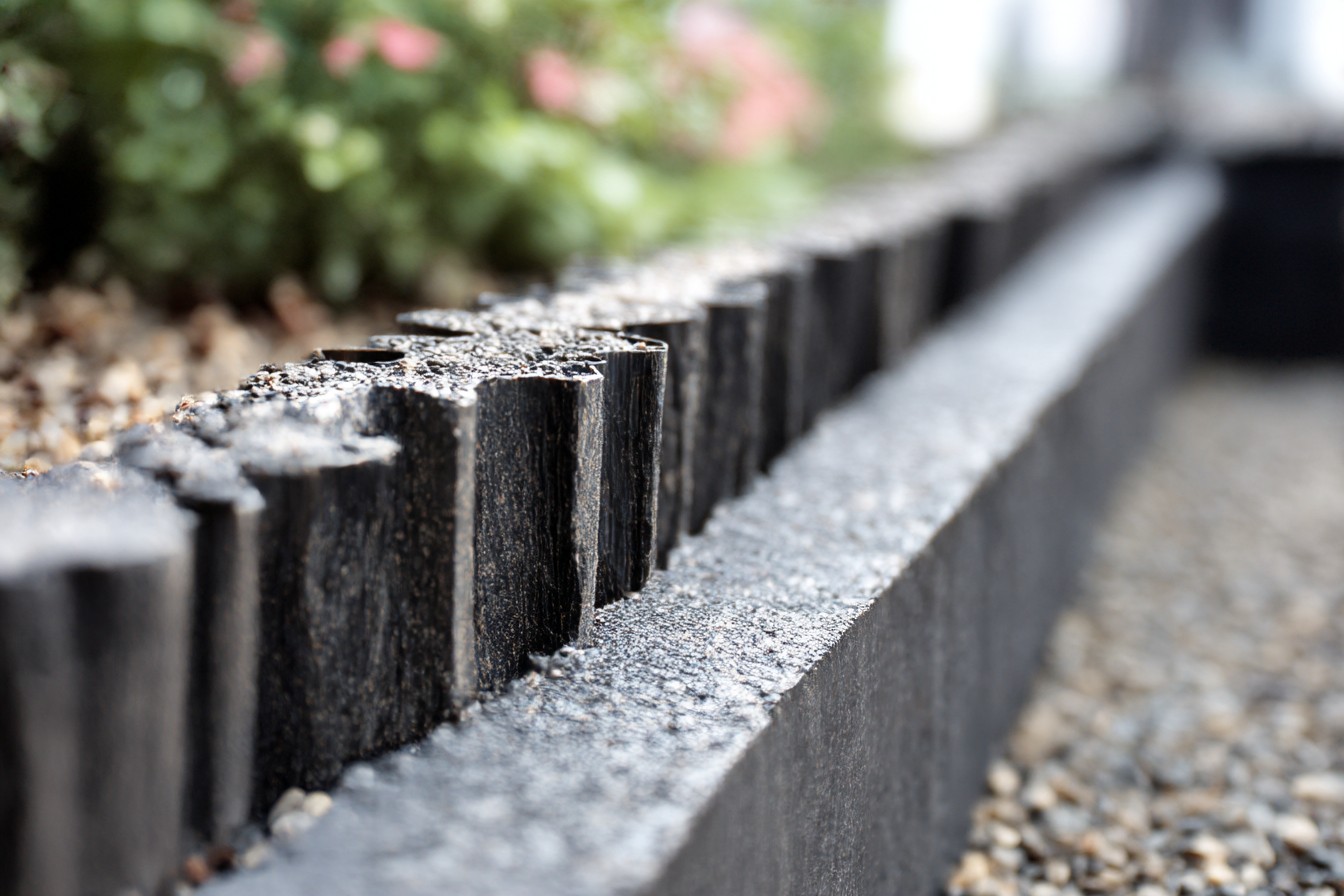
For properties with significant grade changes, stepped edging provides both visual interest and erosion control. A Seattle client with a sloped garden previously used continuous edging that created channels for water runoff during heavy rains. By redesigning with stepped stone sections that followed the natural contours while creating small check dams at appropriate intervals, we transformed problematic erosion zones into stable, visually appealing transitions. This approach cost approximately 20% more than continuous edging but eliminated recurring erosion damage that had previously required annual repairs.
Edging material scale should relate appropriately to overall landscape dimensions. A common mistake involves selecting substantial materials for small spaces, creating visually overwhelming borders that dominate rather than define garden areas. For a modest urban property in Boston with limited space, we selected thin cast concrete edging that provided necessary definition while maintaining appropriate proportional relationships with compact garden beds and narrow pathways. Conversely, undersized edging in expansive landscapes often appears insubstantial and fails to provide adequate visual or functional separation between different zones.
Regional soil conditions dramatically impact appropriate edging selection and installation requirements. In areas with heavy clay soils, such as parts of Texas, expansion and contraction during wet-dry cycles can dislodge insufficiently anchored materials regardless of their weight or substantiality. For a Dallas project, we specified concrete edging with additional below-grade depth specifically to address the region’s challenging soil conditions. The incremental installation cost prevented the recurring maintenance that would have been necessary with standard-depth installation in highly reactive clay.
For regions with aggressive root systems, flexible edging materials often perform better than rigid alternatives. A client in Florida dealing with extensive surface roots from established oak trees found that traditional concrete edging repeatedly cracked and heaved as roots continued to grow. Switching to connected aluminum sections allowed necessary flex while maintaining continuous borders as the landscape evolved. This adaptability represents a legitimate advantage for certain conditions where exceptional rigidity might actually reduce long-term performance.
Edging selection should acknowledge realistic maintenance capabilities rather than aspirational intentions. A retired client in Arizona initially requested formal boxwood parterre gardens with precision-cut stone edging, similar to historic European examples they had admired. After honest discussion about the weekly maintenance such designs require, we developed a modified approach using more forgiving native plantings contained by natural stone borders that accommodated occasional imprecision while still providing clear landscape definition. This realistic assessment prevented what would have become a maintenance burden exceeding their actual capacity and interest.
The most successful landscape edging solutions I’ve encountered share certain characteristics regardless of material or regional conditions. They provide appropriate definition without drawing undue attention to themselves. They accommodate natural processes like water movement, plant growth, and seasonal changes without failing. They require minimal maintenance while preventing additional work through material containment. And perhaps most importantly, they establish harmonious relationships between different landscape zones that enhance rather than detract from the overall composition.
Our Minneapolis garden beds, five years after replacing that failed plastic edging with properly installed limestone borders, demonstrate these principles in action. The substantial stone provides clean definition between lawn and perennial areas without requiring constant maintenance. Spring cleanup involves minimal edge restoration compared to the complete rebuilding previously necessary. Mulch remains contained within garden beds even during heavy rainfall. And visually, the limestone connects naturally to both our home’s architecture and the surrounding landscape context.
The initial investment—roughly four times what those plastic strips had cost—has been repaid many times over through reduced maintenance, eliminated material replacement, and enhanced landscape performance. Like so many home improvement decisions, quality edging represents an investment in long-term functionality rather than a pure expense. The best solutions address your specific regional conditions, maintenance capabilities, and aesthetic context while providing infrastructure that actually works rather than merely looking acceptable on installation day. Because ultimately, the true test of landscape edging comes not when it’s first installed, but during the inevitable forces it will face through seasons of rain, growth, temperature fluctuations, and regular maintenance activities.